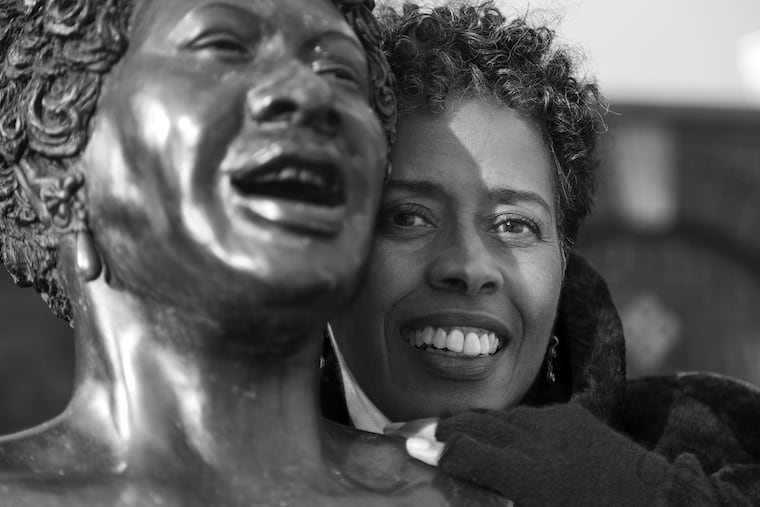The statue of Sadie Tanner Mossell Alexander, commissioned by Mayor Cherelle L. Parker’s administration, is inching closer to realization.
Parker unveiled celebrated sculptor Vinnie Bagwell’s design titled The First Lady of of the Law: Sadie Tanner Mossell as the design competition’s winner on Wednesday.
The First Lady of Law will stand tall in Thomas Paine Plaza, once the permanent home of former Philadelphia police chief and Mayor Frank Rizzo’s statue. Rizzo’s statue was unceremoniously removed in 2020 because of what many consider Rizzo’s history of racist policing.
The magic of Bagwell’s design will be held within the folds of Sadie Tanner Mossell Alexander’s University of Pennsylvania Law School’s graduation regalia.
Alexander — born in 1898 to Philadelphia’s prominent Tanner and Mossell families — was the first Black woman to earn a PH.D in economics from the University of Pennsylvania in 1921. In 1927, she became the first Black woman to graduate from Penn’s law school.
Coming of age before women had the right to vote, Alexander, Bagwell said, was likely inspired by her notable family members and elite social circles including her uncle, Nathan Francis Mossell — the first Black man to graduate from Penn’s medical school — and influential writers and activists Frederick Douglass, W.E.B. Du Bois, and Mary Church Terrell.
Theirs, Bagwell said, are among the dozens of faces she plans to etch into the folds of Alexander’s bronze and black patina robes, a celebration not just of Alexander but also of her unsung and ancestors and acquaintances who contributed to Alexander’s greatness.
“These were some of the most progressive minds of the 19th and 20th century,” Bagwell said Wednesday shortly after Mayor Parker’s announcement.
“I want people to know that almost nobody makes it by themselves,” Bagwell said. “Everyone has people who support and help them. These pioneers immortalized in her robe shaped her perspectives that led her to break barriers and change history.”
Bagwell, who was selected from a pool of five finalists announced in June, will have a budget of $700,000 for the statue, plus the city’s standard 18% design fee of $126,000.
The work will be unveiled in spring of 2027.
Alexander’s statue is the third statue of a historical Black woman with Philadelphia ties. Life-size monuments of Harriet Tubman and Marian Anderson will be erected in front of City Hall and the Marian Anderson Hall at the Kimmel Center, respectively.
“It’s an honor and my pleasure to immortalize Dr. Sadie T.M. Alexander’s legacy in a way that encourages ongoing engagement in the struggle for equity,” Bagwell said.
Capturing her essence
Alexander, who died in 1989, made Philadelphia history during the mid-20th century as a founding member of Philadelphia’s Commission on Human Relations. She was the first Black woman to serve as assistant city solicitor and was a member of President Harry S. Truman’s Committee on Civil Rights. She was also the first bational president of Delta Sigma Theta Sorority.
The First Lady of the Law will be set on a low, wide-beveled, black granite pedestal. Alexander’s famous quote: “The future of our nation depends upon our willingness to uphold democracy and justice for all,” will be inscribed on the base.
Bagwell’s sculpture of Alexander will be shown holding a copy of the U.S. Constitution open to the Fourteenth Amendment, highlighting the equal protection clause. This, Bagwell said, is a timely message that reminds us “constitutional rights are not static and require vigilant defense and reinterpretation across generations.”
Alexander’s outstretched hands welcomes those searching for change. Bagwell will show her dressed in her graduation robes, with a shorter dress underneath. She will wear a straw cloche adorned with magnolias signifying strength and resistance, capturing her essence as a young woman but foreshadowing who she will become.
“Ms. Bagwell’s design captured the essence of my mother’s being: her spirit, grace humanity, intellect and commitment to justice and equality for all who came before,” Rae Alexander-Minter, Alexander’s daughter and member of the 19-person selection committee, said in a press release. The committee chose Bagwell’s work unanimously. Public input gained through a voting process “informed” the decision.
A self-taught artist
Bagwell, 68, lives in Yonkers and comes from a family of artists. A graduate of Morgan State University, she worked as a journalist at Gannett Suburban newspapers and the Harlem Times before turning her focus to art full time in the 1990s.
She’s a self-taught artist whose signature bas-relief technique — the technique that raises George Washington’s silhouette in a quarter — has made her one of the most sought out contemporary American sculptors.
Her first public artwork was The First Lady of Jazz: Ella Fitzgerald commissioned by the city of Yonkers in 1996 to welcome passengers into the Metro-North Amtrak Station.
This year, her nine-foot Black angel Victory will replace a sculpture of the problematic 19th century gynecologist J. Marion Simms at New York City’s Central Park’s Fifth Avenue entrance at 103rd Street. Instead of centering Simms, who experimented on enslaved and poor immigrant women’s bodies, Bagwell’s angel centers the price these women paid with their bodies. “It’s a flipping of the narrative,” Bagwell said.
Bagwell’s seven-foot statue of Harriet Tubman will be installed at Niagara Falls’ Underground Railroad Heritage Center this fall.
In 2022, Bagwell’s likeness of civil rights leader the Rev. James Lawson was installed at Pennsylvania State University’s Eberly Campus.
“My goal is to translate the struggles and triumphs of marginalized Black people into universal stories that speak to the shared human condition of all people, regardless of race, ethnicity, nationality or background,” Bagwell wrote in her proposal. “My subjects have souls who speak to the viewer, and they are meant to be engaged.
